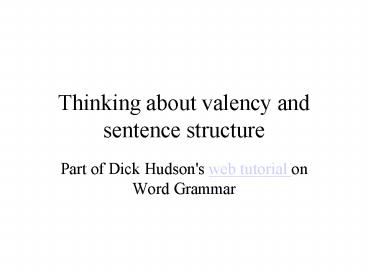Thinking about valency and sentence structure - PowerPoint PPT Presentation
1 / 14
Title: Thinking about valency and sentence structure
1
Thinking about valency and sentence structure
- Part of Dick Hudson's web tutorial on Word Grammar
2
How to view this tutorial
- As with the previous tutorial, you must watch the
slideshow, not 'normal' view. - To do this, hit f5 or click 'View', then
'slideshow'. - Move through the show by hitting either 'Enter'
or 'Page Down' - so-called 'Page down' just moves down one line.
- 'Page Up' takes you back a line.
- Exit' takes you out of the slideshow.
3
Main points
- Syntactic analysis combines
- the valencies of individual words
- micro-analysis
- the meaning of the whole sentence
- macro-analysis
- Think global and act local!
- analyse one word at a time
- but remember the rest of the sentence.
4
For example,
- I like this grammar course.
- n V,t n N N
- Focus on this
- valency a common noun as complement
- Question which N is its complement?
- Ask 'This what?
- This grammar?
- This course?
c
N
c
I like this grammar course.
c
I like this grammar course.
5
Confirming your analysis
c
- this grammar
- But what does course depend on?
- And where's the determiner that course needs?
- this course
- What does grammar depend on?
- course
- So this analysis is right.
I like this grammar course.
c
I like this grammar course.
c
a
I like this grammar course.
6
Some principles
- Respect meaning
- Choose analyses that fit the sentence's meaning.
- Respect syntax
- Choose analyses that satisfy the dependency needs
of neighbouring words. - Analyse easy words first
- Their analyses will help with harder words.
- Then work back from the last word!
7
For example,
- I saw the man with the telescope.
- Uncertainty
- saw with?
- man with?
- Both are OK syntactically
- WITH can depend on V or on N
- But they give different meanings.
- So what does the sentence mean, in context?
a
I saw the man with the telescope.
a
I saw the man with the telescope.
8
In contrast,
- The man with the telescope saw me.
- Uncertainty
- saw with?
- man with?
- Saw with isn't allowed syntactically
- WITH always follows its parent
- Except when front-shifted before the man
- With the telescope, the man saw me
- So only one analysis is possible man with
a
The man with the telescope saw me.
a
The man with the telescope saw me.
9
Starting at the end
- The last word probably has no dependent.
- Most words follow their parent.
- And it probably depends on the word just before
it. - Most words are next to their parent.
10
For example,
- I 've bought a book about food in France.
a
a
p
c
c
c
o
s
've needs a subject noun. I needs a parent finite
verb. A perfect match!
Bought needs a parent HAVE. 've needs a
predicative perfect participle. A perfect match!
s
France needs a parent. In needs a complement
noun. A perfect match!
Food needs a parent. About needs a complement
noun. A perfect match!
Book needs a parent pronoun. The pronoun a needs
a complement common noun. A perfect match!
've needs no parent. So it's perfect without one!
About needs a parent (e.g. noun) Book is a
noun. A perfect match!
've has a subject. Its predicative needs a
subject to share. A perfect match!
In needs a parent noun . Food is a noun. A
perfect match!
A needs a parent. Bought needs an object noun. A
perfect match!
11
Harder cases
- If you really can't see how a word fits in, just
leave it without a dependency. - Maybe later sections will show you the way.
- Respect existing dependency arrows.
- They help by limiting your options
- But of course they may be wrong check them!
12
For example,
Possible, but what about the fact?
No! Crossed arrows aren't allowed!
?
?
?
?
?
?
s
c
s
s
c
s
p
c
s
a
c
o
- The fact that it rained didn't spoil the
party.
n N t n V,a v,a
V,n n N
To warm up, add word classes.
Pair valent and parent '?'s, starting in the
middle.
Start at the end.
Do any remaining easy dependencies.
Find adjuncts' parents.
Add incomplete dependencies in pencil.
Tidy up
Avoid crossing arrows!
13
Tidying up
?
c
c
s
s
p
c
s
a
a
c
o
- The fact that it rained didn't spoil the
party.
n N t n V,a v,a
V,n n N
s
Find a finite verb that has no parent, and mark
it as sentence root.
Confirm pencilled dependencies.
Add syntactic triangles for predicatives.
14
Good luck!
- Finding dependencies is the hardest part of
syntactic analysis. - But it's also the most interesting, because
- it's challenging
- it shows how words express complex meanings
- you may learn some new tricks for your own use of
syntax.































